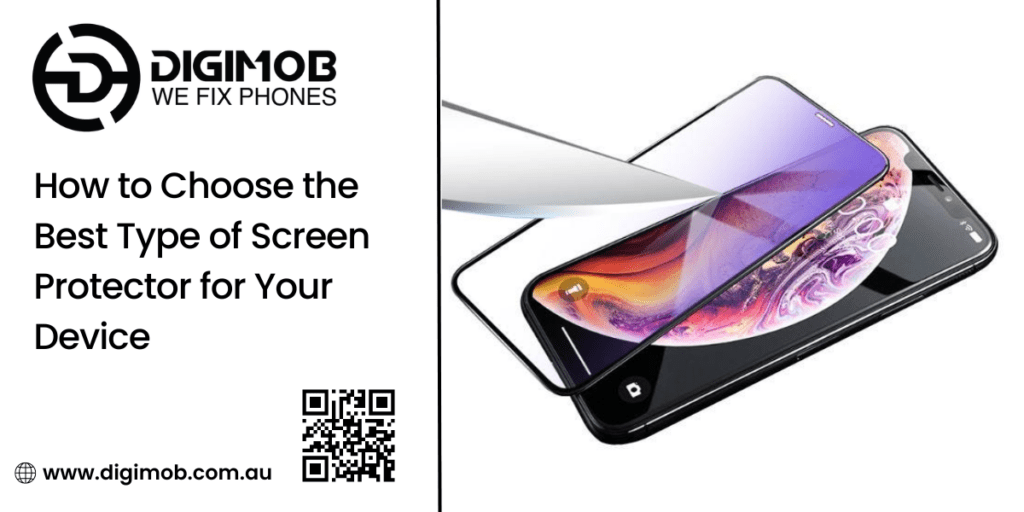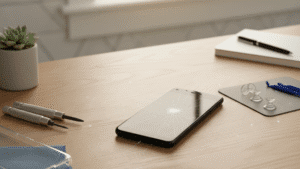Screen protectors are essential for keeping your device’s screen free from scratches, cracks, and other damage. With a variety of options available, it can be challenging to determine which type is best suited for your device. Here’s a guide to help you choose the best screen protector for your needs.

Understanding Different Types of Screen Protectors
- Plastic Film Protectors: These are typically the most affordable and readily available options. Made from thin sheets of plastic, they provide basic protection against scratches and minor abrasions. While they are less durable compared to other types, they are easy to apply and replace.
- Tempered Glass Protectors: Known for their durability and superior protection, tempered glass protectors are made from multiple layers of glass that have been treated to increase their strength. They offer excellent protection against drops and impacts, and they also feel more like the original screen. Tempered glass protectors are generally thicker and slightly more expensive than plastic film protectors.
- Liquid Screen Protectors: These protectors use a liquid solution that is applied directly to the screen and then cured to form a protective layer. They are virtually invisible and do not affect the touch sensitivity of the device. While they provide decent protection against scratches, they may not offer as much impact resistance as tempered glass protectors.
- Anti-Glare Protectors: These screen protectors have a matte finish that reduces glare from sunlight and indoor lighting, making it easier to see the screen in bright conditions. They are usually made from plastic film or tempered glass and are ideal for those who frequently use their devices outdoors or in brightly lit environments.
- Privacy Screen Protectors: Designed to protect your screen from prying eyes, privacy screen protectors limit the viewing angle of your device. This means that only someone directly in front of the screen can see what’s displayed, while those looking from the side will see a darkened screen. Privacy protectors are available in both plastic film and tempered glass varieties.
Factors to Consider When Choosing a Screen Protector
- Device Compatibility: Ensure that the screen protector is specifically designed for your device model. This will guarantee a perfect fit and full coverage, including any cutouts for cameras and sensors.
- Protection Level: Consider how much protection you need. If you’re prone to dropping your device, a tempered glass protector might be the best option due to its superior impact resistance. For basic scratch protection, a plastic film protector may suffice.
- Installation Ease: Some screen protectors come with installation kits to help you apply them without bubbles or misalignment. If you’re not confident in your ability to install a protector yourself, look for one with an easy installation process or consider having it professionally applied.
- Touch Sensitivity: A good screen protector should not interfere with the touch sensitivity of your device. Tempered glass protectors generally maintain the original feel of the screen, while some plastic film protectors might reduce sensitivity slightly.
- Price: Screen protectors come in a wide range of prices. While it might be tempting to go for the cheapest option, investing in a higher-quality protector can save you money in the long run by preventing costly screen repairs.
Additional Tips
- Read Reviews: Before purchasing a screen protector, read customer reviews to get an idea of its durability, ease of installation, and overall quality. Reviews can provide valuable insights from other users who have already tested the product.
- Check Warranty: Some screen protectors come with warranties that cover defects or even screen damage while the protector is in use. This can provide additional peace of mind and make the investment more worthwhile.
- Consider Multipacks: If you’re prone to damaging screen protectors or want to have spares on hand, consider purchasing a multipack. This can be more cost-effective and ensure you always have a backup ready.
Choosing the right screen protector involves considering your specific needs and preferences. By understanding the different types available and evaluating key factors, you can find the perfect screen protector to keep your device safe and functional.
Clarity and Display Quality
The clarity of your screen protector can significantly impact your viewing experience. High-quality protectors, particularly tempered glass ones, maintain the original display quality of your device, ensuring that colours remain vibrant and text is sharp. Some cheaper plastic film protectors might cause slight blurring or reduce the brightness of your screen. When choosing a screen protector, look for ones that advertise high transparency and minimal impact on display quality.
Oleophobic Coating
An oleophobic coating is a thin layer applied to some screen protectors that repels oils and reduces fingerprints. This keeps your screen looking clean and clear, even with frequent use. Tempered glass protectors often come with this coating, making them easier to clean and maintain. If you’re particular about the appearance of your screen, choosing a protector with an oleophobic coating can be a smart move.
Edge-to-Edge Protection
Edge-to-edge screen protectors cover the entire front of your device, including the curved edges found on some models. This type of protector offers more comprehensive coverage, reducing the risk of damage to the edges of your screen. When shopping for a protector, check if it provides edge-to-edge coverage, especially if your device has a curved screen.
Thickness and Weight
The thickness of a screen protector can affect its durability and feel. Tempered glass protectors are generally thicker (around 0.3mm to 0.5mm) compared to plastic films (which are about 0.1mm thick). While thicker protectors offer better protection, they can add slight bulk to your device. If you prefer a lightweight, unobtrusive protector, a high-quality plastic film might be more suitable, despite its lower impact resistance.
Anti-Blue Light Protection
Some screen protectors come with an anti-blue light feature that reduces the amount of blue light emitted by your screen. Blue light can cause eye strain and disrupt sleep patterns, particularly if you use your device extensively at night. If you’re concerned about eye health, consider a screen protector that filters blue light. These are available in both plastic film and tempered glass options.
Compatibility with Cases
If you use a protective case on your device, ensure that the screen protector you choose is compatible with it. Some edge-to-edge protectors might lift or peel off if used with a case that fits tightly around the screen’s edges. Look for screen protectors labelled as “case-friendly,” which are designed to work seamlessly with most protective cases.
DIY Installation vs. Professional Application
While many screen protectors are designed for easy DIY installation, some people prefer professional application to avoid bubbles and misalignment. Retailers often offer installation services for a small fee. If you’re not confident in your ability to apply a protector without issues, it might be worth considering professional installation, especially for more expensive protectors like tempered glass.
Environmental Considerations
If you’re environmentally conscious, you might want to consider the materials and packaging of the screen protector. Some brands offer eco-friendly options made from recycled materials or packaged with minimal plastic. While these options might be slightly more expensive, they can reduce your environmental footprint.
Durability and Longevity
Consider the expected lifespan of the screen protector. High-quality tempered glass protectors can last for years without needing replacement, whereas plastic film protectors might need to be replaced more frequently due to scratches and wear. Investing in a durable protector can provide long-term savings and better protection for your device.

Return Policy and Customer Support
Finally, check the return policy and customer support options provided by the seller. A good return policy allows you to exchange or return the protector if it doesn’t fit your needs or has defects. Reliable customer support can assist you with any installation issues or questions about the product. Opt for brands that offer solid warranties and responsive customer service to ensure a hassle-free experience.
Do you have gadget glitches? No worries! ????️ From laptops ????️ to iPhones ????, MacBooks ???? to iPads, and even Samsung, Android phones, and all other major brands, we’ve got you covered! ???? Our team offers swift and reliable repairs for all your digital needs. ???? Visit digimob.com.au today!
By considering these additional factors, you can make a well-informed decision when choosing the best screen protector for your device. Whether prioritising durability, clarity, ease of installation, or environmental impact, there’s a screen protector out there that meets your specific needs and keeps your device’s screen safe and pristine.
FAQs About Choosing the Best Type of Screen Protector for Your Device
1. What is the difference between a plastic film screen protector and a tempered glass screen protector?
Plastic film screen protectors are thin, flexible sheets of plastic that provide basic protection against scratches and minor abrasions. They are lightweight and affordable but offer limited impact resistance. Tempered glass screen protectors, on the other hand, are made from multiple layers of glass that have been treated for added strength. They are thicker and more durable, providing superior protection against drops and impacts while maintaining the original feel and clarity of the screen.
2. How do I know if a screen protector will fit my device properly?
To ensure a proper fit, choose a screen protector specifically designed for your device model. Check the product description for compatibility details. Many screen protectors also indicate whether they provide edge-to-edge coverage or are case-friendly. Reading customer reviews can also give you an idea of how well the protector fits various devices.
3. Can a screen protector affect the touch sensitivity of my device?
High-quality screen protectors, especially tempered glass ones, are designed to maintain the touch sensitivity of your device. However, some lower-quality plastic film protectors might slightly reduce sensitivity. When purchasing a screen protector, look for ones that advertise minimal impact on touch sensitivity and check customer reviews for any feedback on this aspect.
4. Are liquid screen protectors as effective as traditional screen protectors?
Liquid screen protectors offer a virtually invisible layer of protection that can reduce scratches and minor abrasions. However, they may not provide the same level of impact resistance as tempered glass protectors. Liquid protectors are a good option for those who want a seamless look and feel, but if you need robust protection against drops, a tempered glass protector might be more suitable.
5. How can I avoid bubbles when applying a screen protector?
To avoid bubbles, clean your screen thoroughly before application using a microfiber cloth and the cleaning solution provided. Ensure there are no dust particles or fingerprints. Some screen protectors come with an installation kit that includes tools to help align the protector accurately. Start applying the protector from one end and slowly lay it down, using a squeegee or a credit card to smooth out bubbles as you go. If bubbles persist, gently lift the protector and reapply it, smoothing out any air pockets.


